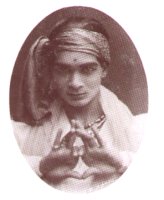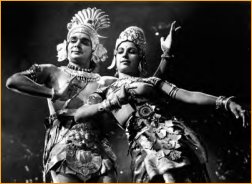Narthaki

News

Info

Featured

 |
  |
The Uday Shankar story - Nayana Bhat, Bangalore e-mail: nritarutya@rediffmail.com September 26, 2007  Contemporary is neither tomorrow nor yesterday. Contemporary is not bound to anything. Something that has change as a constant and speaks today's language is contemporary. It is the present. And, I feel, this quite clearly describes what is today called as contemporary Indian dance. But one should remember that "Indian Contemporary Dance" does not bear much resemblance to the Modern dance of the west. The main difference being, Modern dance has its own set techniques and the strong base of Classical Ballet. Whereas, Indian contemporary dance is a newborn, being not older than a few years. There are no set frameworks, though the techniques, stance and the style could be based on various Indian dance forms and martial arts. Indian contemporary dance is contemporary in its true sense, as no framework binds it. This boundless nature has helped it grow and support newer forms of experiments in dance.  Dance has its own ways of touching people's senses. On this man, it was more of a blow than just a touch. And the effect was enormous. The Father of Modern Dance in India was completely swept away by the spell of dance. When the world around him was basking in the glory of Bharatanatyam, Kathak and Odissi, Uday Shankar (1900-1977) was busy exploring new possibilities in dance through his exclusive innovations. Not that he did not appreciate classical forms. But he did not blindly perform what was taught to him. Instead, he made his contributions, which were rightly recognized by one and all, earning him the title "Father of Modern Indian dance." Uday Shankar, being born in an artistically inclined family, quite naturally, grew up to take up fine arts as his career. After his basic training in arts from J J School of Arts and Gandharva Mahavidyalaya, Udayshankar went to Royal School of Arts, London, for higher studies. In the UK, he was introduced to various performing artistes of Britain. Soon, with his extraordinary skills in painting, he acquired a scholarship that sent him to Rome to study painting. And in a little while he was traveling through Europe, where he came across several contemporary artistes. His idea of giving a new dimension to Indian dance came up when he met the great Russian Ballerina Anna Pavlova. The meeting was a phenomenal one, as it gave him a whole new perspective about dance presentations. Pavlova intended to work on Indian-based themes such as Radha-Krishna and Hindu marriage. And she found her best choice in Uday Shankar. Both the artistes together, at their show in Royal Opera House, presented their ballet on Radha and Krishna that drew huge applause from the European audience. This entire experience inspired Uday Shankar to introduce new aspects to Indian dance. When he returned to India after his studies, he returned with a vision and a determination to realize it. He was accompanied by a French pianist, Simon Barbiere, who was now his disciple and dance partner, and a Swiss sculptress, Alice Bonner, who wanted to study Indian art history. The three traveled across the country, performing their work, reaching out to all nooks and corners of the nation. After a series of trips to various places, he realized that Indian culture had much more to offer than what he was aware of. With this realization, he set out on a new campaign for knowledge. He made trips to several villages and remote places, where he studied different folk art forms. He was highly intrigued by the diversities that various classical dance forms had in store to offer. Out of a range of art forms that he was introduced to, he chose Kathakali from Kerala and popularized it all over west Bengal.  His extended understanding of Indian dance forms helped him greatly in his movement vocabulary. This reflected in all of his productions. He performed his outstanding dancing skills all over Europe and the United States. This acted as an exceptional movement across the west in popularizing Asian dance forms and elaborated the richness they consist of. What also added to the movement was the dance company established by Uday in France by name "Compagnie Uday Shankar De Dance Musique Hindous." Understanding his tremendous capacity to advocate dance in the country, veteran artistes like Rabindranath Tagore persuaded him to open a performing arts school in India. In 1939, Shankar India Cultural Centre was established at Almora, in the foothills of the Himalayas. It included training options in Kathakali under Shankaran Namboodri, Bharatanatyam under Kandappa Pillai, Manipuri under Amobi Singh and classical music under Ustad Allauddin Khan. Soon, it turned out to be a centre for great music and dance artistes to come together. But this was a short-lived glory, as the Centre had to shut down in a few years due to lack of funds. But Uday Shankar's contribution was not restricted to stages only. He furthered his talent into movies that became showcases for his dance. He made a movie "Kalpana" that featured him with his wife, Amala Shankar and was a witness to his extraordinary choreography and performance skills. With his talent and ability to persuade his audience to appreciate, he gained the masses' respect for dance as an art form. His work acquired him acclaims from the Indian Government as well, who recognized him with the Padma Vibhushan award, the second highest honor that the Govt of India credits to achievers. Uday Shankar, unquestionably, laid the foundation stone for Indian contemporary dance. He gave the initial momentum to the movement, which, of course, took decades to pick up. But sooner or later, the movement had to be recognized, thanks to its vast potential for expression in the art field. What make Uday Shankar an irreplaceable, are his futuristic vision and his bent of mind for novel ideas, which, invariably, are traits in great men. Nayana Bhat is a dancer in Bangalore based contemporary dance company Nritarutya. |